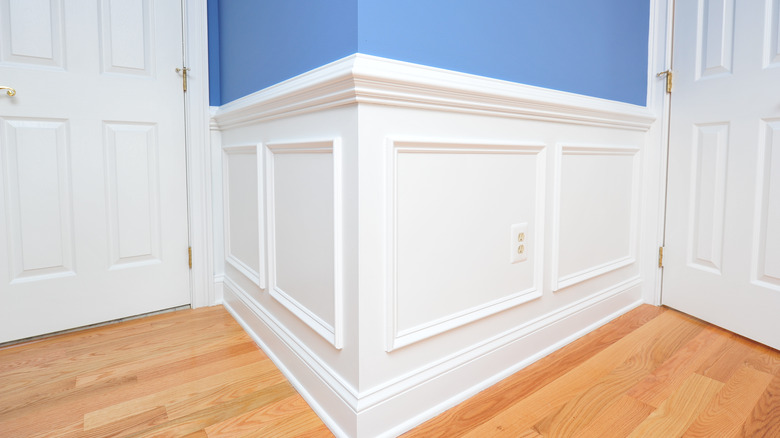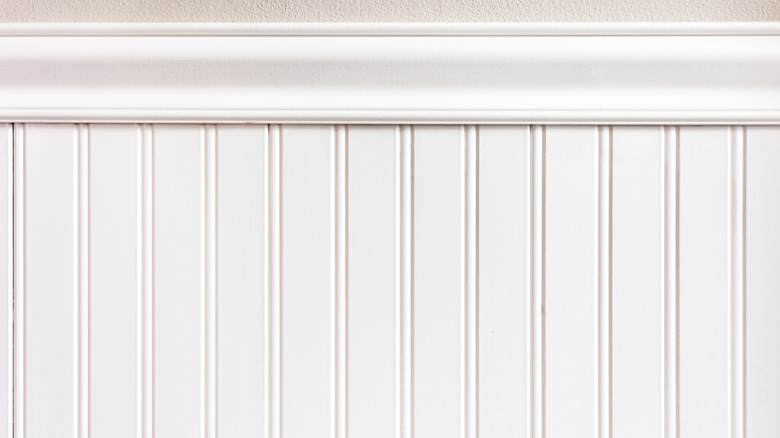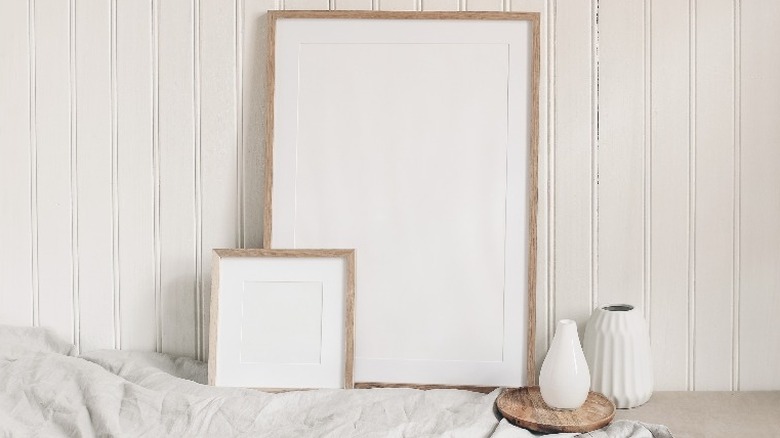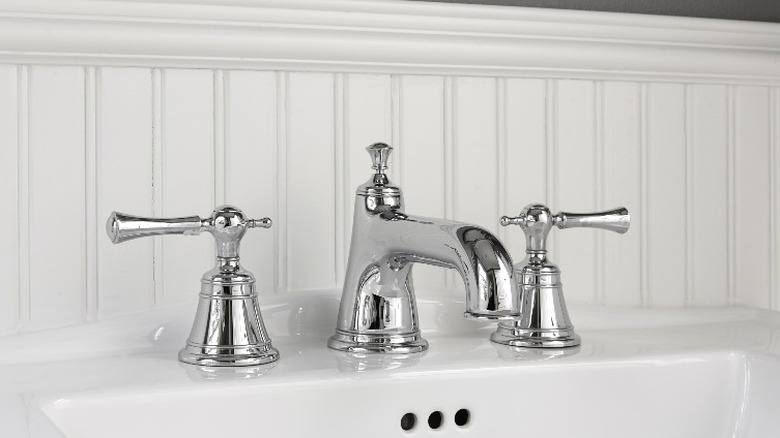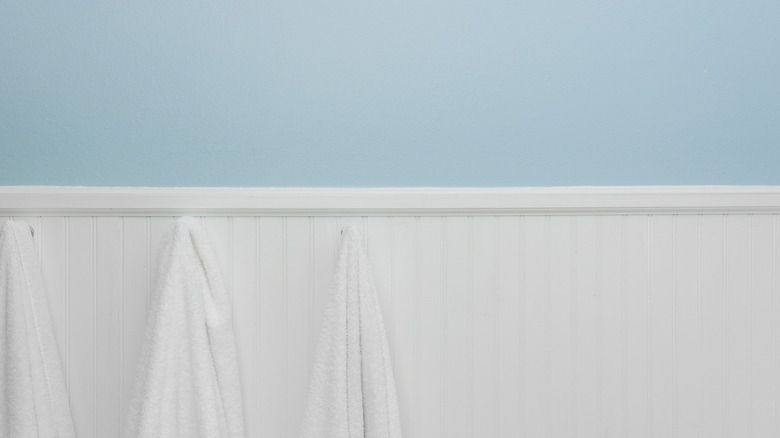What's The Difference? Wainscoting Vs. Beadboard
Wainscoting and beadboard are two words that get mixed up when people talk about interior design. Hosts on home design shows, real estate agents, and interior designers all use words the way they've learned them from others. So, if you've been using the words interchangeably, you're not alone. Here's the inside scoop on wainscoting vs. beadboard.
Wainscoting is the broader term to describe decorative wall paneling, per Schutte Lumber Co. It's been around for centuries and was used to insulate and protect interior walls from being scratched and banged. Originally, it was made of solid wood which was not as easily damaged as plaster walls. The more wealth you had, the more decorative it could be — think cathedrals and castles. Wainscoting can be seen in raised panel, flat panel, and board and batten patterns and is more formal and decorative. As for beadboard, it is one style of wainscoting. You can use it anywhere, as noted by SFGate. It's often seen on the walls in entry ways, along a staircase, in a kitchen, dining room, or bathroom.
Both wainscoting and beadboard can be installed one-third of the way up a wall and capped with trim called a chair rail to prevent chairs from banging the walls. Beadboard can also be placed on the lower two-thirds of a wall, and capped with a narrow piece of trim, referred to as a plate rail (via the Chicago Tribune). This can be used to display plates, framed pictures or other decorative items.
How does the appearance of wainscoting differ from beadboard?
Beadboard's appearance differs from other types of wainscoting because of the evenly-sized narrow boards installed in a vertical pattern. This Old House describes beadboard as having interlocking tongue-and-groove cuts along their side lengths so that they snug up tightly against one another when installed. Another difference is that the flat section of each board is separated from the next by a little indentation that rises up into a rounded half-circle, known as a "bead." The flat surface ranges in width from 1 ½-inch to 4-inches wide depending on whether you want a narrow pattern of beadboard or a wider one.
The appearance of traditional wainscoting is recognizable by the panels of wood framed by moulding. The panel can either be topped by moulding to give it a flat panel look or have a beveled edge which makes it look raised when it is trimmed by the moulding.
How does the composition of wainscoting differ from beadboard?
Wainscoting and beadboard are traditionally made of solid wood, which is the most expensive option. They can also be made from medium density fiberboard (MDF), PVC, or plywood, which are less expensive materials. One difference in the composition of wainscoting and beadboard is that wainscoting can be purchased in 3-foot by 4-foot panels which includes the moulding, while beadboard is sold in 4-foot wide by 8-foot high manufactured panels. These panels, which are made of high density fiberboard or MDF, are easier and faster to install. Some manufacturers like Craftsman or Country Cottage sell these panels already primed and painted.
American Beadboard specializes in beadboard and offers these panels in varying heights of 30, 36, 46, or 60 inches tall. When combined with the top cap molding and baseboard moldings the finished heights will increase by 6 feet. You can also purchase 94-inch beadboard panels for taller applications, and for ceiling projects and they can be special ordered in lengths up to 120 inches.
While solid wood is the most sturdy material, it might not be the best choice depending on where you want to install it, per This Old House. Wood contracts and expands when exposed to moisture and temperature changes. It can also be damaged by water. If you are thinking of using wainscoting or beadboard in a bathroom or a basement you may want to choose a water-resistant MDF or even PVC.
What are the differences in cost?
According to Bob Vila, pine is wood most often used to create beadboard planks. At Home Depot, a box of unfinished pine beadboard planks can cost $1.84 per square foot. Each of the planks in this example are 8 feet wide by 3 feet and 11/16-inches tall and come 18 to a package. If you wanted to install this beadboard 3 feet up from your baseboard molding, you could purchase enough planks to cover a 16-foot wide space for just under $77. MDF and PVC are less expensive, according to Bob Vila. There are other costs associated with installing beadboard include pieces of cap molding, primer and paint, and materials needed to secure the beadboard to the walls or ceilings. Professional installation costs could add another $2 to $3.50 per square foot.
The average cost of wainscoting is $23.50 per square foot, according to Home Advisor. It is frequently priced this way instead of per panel. Price varies between the type of panel, too. Flat panel wainscoting has a minimalist design with limited decorative moulding and costs $7 to $10 per square foot. Raised panel moulding with its beveled middle panels costs $10 to $30 per square foot. Installation costs of a contractor add $2 to $4 per square foot for labor time only.
How easy are wainscoting and beadboard each to DIY?
This Old House says that installing individual wood beadboards as a DIY project is easy, but they add that it requires hundreds of cuts to make and join the boards together. That might not be your idea of easy. Additionally, there are many videos to show you how to install a sheet of beadboard, including this one from Home Depot; it still requires a lot of tools and materials. Can't wait to install beadboard in your home? To get started try your hand on a smaller DIY project.
Contractor Tom Silva offers what he calls an easy hack to installing wainscoting by using the existing wall as your panel and topping it with trim moulding in a way that mimics the look of traditional wainscoting (via This Old House). Installing wainscoting this way still requires an intermediate level of skill, as well as a miter saw and a nailgun. Traditional wainscoting or beadboard are beautiful ways to add decorative finishes to your wall, whether you do-it-yourself or hire a contractor.
